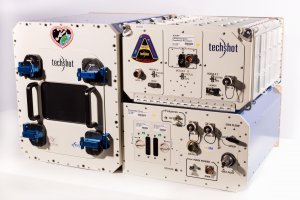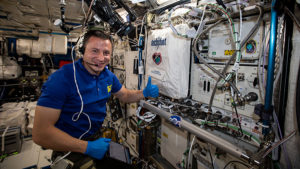Techshot’s Bioprinter Successfully Fabricates Human Menisci in Space
 Techshot’s BFF, which aims to print organ-like tissues that could one day lead to 3D printing human organs in space for transplants, was used to successfully manufacture test prints of a partial human meniscus aboard the ISS last month. The meniscus pattern was manufactured for the company’s customer: the 4D Bioprinting, Biofabrication, and Biomanufacturing (4D Bio3) program, which is based at the Uniformed Services University of the Health Sciences (USU). The program is a collaboration between the university and The Geneva Foundation, a non-profit organization that advances military medical research.
Techshot’s BFF, which aims to print organ-like tissues that could one day lead to 3D printing human organs in space for transplants, was used to successfully manufacture test prints of a partial human meniscus aboard the ISS last month. The meniscus pattern was manufactured for the company’s customer: the 4D Bioprinting, Biofabrication, and Biomanufacturing (4D Bio3) program, which is based at the Uniformed Services University of the Health Sciences (USU). The program is a collaboration between the university and The Geneva Foundation, a non-profit organization that advances military medical research.
Manufacturing human tissue in the microgravity conditions of space could ultimately aid in the race to manufacture hearts and other organs using a 3D bioprinter. Although the actual fabrication of functional organs that could finally replace the shortage of donor organs to help patients in need of a transplant could be a decade away – if not more – the team at Techshot was optimistic around this project since research in space might illuminate a lot of the work done on Earth.
In the last six months, astronauts, like NASA’s flight engineer Christina Koch, have tested the ability of the BFF to print cells. Using adult human cells (such as stem or pluripotent cells) and adult tissue-derived proteins as its bioink, the BFF is able to create viable tissue.
According to the ISS U.S. National Lab, although researchers have had some success with 3D printing of bones and cartilage on Earth, the manufacturing of soft human tissue (such as blood vessels and muscle) has been difficult. What they claim occurs is that, on Earth, when attempting to print with soft, easily flowing biomaterials, tissues collapse under their own weight, resulting in little more than a puddle; but if these same materials are produced in the microgravity environment of space, the 3D printed structures will keep their shapes.
A meniscus, which is a crescent-shaped disc of soft cartilage that sits between the femur and the tibia, acts as a significant cushion or shock absorber, yet when the meniscus tears, the cushioning effect functions poorly, leading to arthritis and knee pain. Meniscal injuries are one of the most commonly treated orthopedic injuries and have a much higher incidence in military service members and sports players.
Early in March, Techshot sent equipment and samples supporting plant, heart and cartilage research for three of its customers to the ISS on SpaceX mission CRS-20. Astronauts on-board the station used the BFF to manufacture human knee menisci as a test of the materials and the processes required to print a meniscus in space. According to Techshot, the first experiment for 4D Bio3 aboard the ISS U.S. National Laboratory served as a test of the materials and the processes required to print a meniscus in space. Astronaut Andrew Morgan, a medical doctor and graduate of USU loaded biomaterials into BFF, while Techshot engineers uploaded a customer-provided design file to the printer from the company’s Payload Operations Control Center (POCC) located in Greenville, Indiana, from which the devices in space are controlled. The success of the print was evaluated via real-time video from inside the unit.
“Some of our criteria for mission success, such as the ability to work with customer-specified print materials and customer-supplied design files, were met before we even launched back on March 6,” said Techshot Senior Scientist Carlos Chang. “But commanding BFF to print from here at Techshot, and watching it all literally come together in real-time, provided the confirmation we needed that we’re on the right track.”
Founded more than 30 years ago, Techshot operates its own commercial research equipment in space and serves as the manager of NASA-owned ISS payloads – such as the Advanced Plant Habitat and two materials-science research furnaces. The company provides its catalog of equipment and services for a fee to those with their own independent research programs – serving as a one-stop resource for organizations seeking access to space. And launched to the station in July 2019 aboard SpaceX CRS-18, the BFF has been tested since. Techshot has even suggested that biomaterials for a second meniscus print, which will be returned to Earth for more extensive testing, will launch on a later SpaceX mission.
As astronauts stationed at the ISS U.S. National Lab continue to advance work with Techshot’s 3D bioprinter and microgravity research, we can expect to hear more about the cutting edge science that is being done that aims to improve patient care. The technology offers a unique opportunity to support bioprinting structures and construct tissues, providing an ideal scenario that will enable remarkable changes to move forth the medicine of the future.
The post Techshot’s Bioprinter Successfully Fabricates Human Menisci in Space appeared first on 3DPrint.com | The Voice of 3D Printing / Additive Manufacturing.
Improvements to the BioFabrication Facility on the ISS Thanks to Lithoz
Scientific discoveries and research missions beyond Earth’s surface are quickly moving forward. Advancements in the fields of research, space medicine, life, and physical sciences, are taking advantage of the effects of microgravity to find solutions to some big problems here on Earth. Researchers in 3D printing and bioprinting have taken advantage of space facilities that are dedicated to conducting multiple experiments in orbit, such as investigating microgravity’s effects on the growth of three-dimensional, human-like tissues, creating high-quality protein crystals that will help scientists develop more effective drugs, and even growing meat with 3D printing technology.
On November 2, 2019, a Northrop Grumman Antares rocket successfully launched a Cygnus cargo spacecraft on a mission to the International Space Station (ISS). The payload aboard the Cygnus included supplies for the 3D BioFabrication Facility (BFF), like human cells, bioinks, as well as new 3D printed ceramic fluid manifolds that replaced the previously used that were printed out of polymers. According to Lithoz – the company behind the 3D printed ceramic fluid manifolds – they are enabling advancements in bioprinting at the ISS.
The additive manufactured ceramics have been in service since November 2019 and Lithoz claims they have proven to provide better biocompatibility than printed polymers, resulting in larger viable structures.
 Lithoz, a company specializing in the development and production of materials and AM systems for 3D printing of bone replacements and high-performance ceramics, printed the ceramic manifolds using lithography-based ceramic manufacturing (LCM) on a high-resolution CeraFab printer in collaboration with Techshot, one of the companies behind the development of the BFF. Moreover, the ceramic fluid manifolds are used inside bioreactors to provide nutrients to living materials in space by the BFF.
Lithoz, a company specializing in the development and production of materials and AM systems for 3D printing of bone replacements and high-performance ceramics, printed the ceramic manifolds using lithography-based ceramic manufacturing (LCM) on a high-resolution CeraFab printer in collaboration with Techshot, one of the companies behind the development of the BFF. Moreover, the ceramic fluid manifolds are used inside bioreactors to provide nutrients to living materials in space by the BFF.
Testing of the ceramic 3D printed manifolds is focusing on biocompatibility, precision, durability, and overall fluid flow properties; and the latest round of microgravity bioprinting in December yielded larger biological constructs than the first BFF attempts in July.
Techshot and Lithoz engineers and scientists worked together to optimize the design and the manufacturing processes required to make it. Techshot Senior Scientist Carlos Chang reported that “it’s been an absolute pleasure working with Lithoz.”
While Lithoz Vice President Shawn Allan suggested that “their expertise in ceramic processing really made these parts happen. The success of ceramic additive manufacturing depends on working together with design, materials, and printing. Design for ceramic additive manufacturing principles was used along with print parameter control to achieve Techshot’s complex fluid-handling design with the confidence needed to use the components on ISS.”
Headquartered in Vienna, Austria, and founded in 2011, Lithoz offers applications and material development to its customers in cooperation with renowned research institutes all over the world, benefiting from a variety of materials ranging from alumina, zirconia, silicon nitride, silica-based for casting-core applications through medical-grade bioceramics.
This work, in particular, highlighted an ideal use case for ceramic additive manufacturing to enable the production of a special compact device that could not be produced without additive manufacturing while enabling a level of bio-compatibility and strength not achievable with printable polymers. Lithoz reported that Techshot engineers were able to interface the larger bio-structures with the Lithoz-printed ceramic manifolds and that the next steps will focus on optimized integration of these components and longer culturing of the printed biological materials. While conditioned human tissues from this mission are expected to return to Earth in early 2020 for evaluation.
Back in July 2019, Gene Boland, chief scientist at Techshot, and Ken Church, chief executive officer at nScrypt, discussed the BFF at NASA’s Kennedy Space Center in Port Canaveral, Florida, how they planned to use the BFF in orbit to print cells (extracellular matrices), grow them and have them mature enough so that when they return to Earth researchers can encounter a close to full cardiac strength. Church described how a tissue of this size has never been grown here on Earth, let alone in microgravity. The 3D BFF is the first-ever 3D printer capable of manufacturing human tissue in the microgravity condition of space. Utilizing adult human cells (such as pluripotent or stem cells), the BFF can create viable tissue in space through a technology that enables it to precisely place and build ultra-fine layers of bioink – layers that may be several times smaller than the width of a human hair – involving the smallest print nozzles in existence.
Experts suggest that bioprinting without gravity eliminates the risk of collapse, enabling organs to grow without the need for scaffolds, offering a great alternative to some of the biggest medical challenges, like supplying bioprinted organs, providing a solution to the shortage of organs.
With NASA becoming more committed to stimulating the economy in low-Earth orbit (LEO), as well as opening up the ISS research lab to scientific investigations and experiments, we can expect to learn more about some of the most interesting discoveries that could take place 220 miles above Earth. There are already quite a few bioprinting experiments taking place on the ISS, including Allevi and Made In Space’s existing Additive Manufacturing Facility on the ISS, the ZeroG bio-extruder which allow scientists on the Allevi platform to simultaneously run experiments both on the ground and in space to observe biological differences that occur with and without gravity, and CELLINK‘s collaboration with Made In Space to identify 3D bioprinting development opportunities for the ISS as well as for future off-world platforms. All of these approaches are expected to have an impact on the future of medicine on Earth.
The post Improvements to the BioFabrication Facility on the ISS Thanks to Lithoz appeared first on 3DPrint.com | The Voice of 3D Printing / Additive Manufacturing.
3D Printing News Sliced: PyroGenesis, Under Armour, Onshape, Apollo 11
Techshot and nScrypt to launch 3D BioFabrication Facility in space
3D Printing Jobs and Career Moves Update, FATHOM, nScrypt, HP, BIOLIFE4D and Apollo Robotics
Zero Gravity Bioprinter is Ready for Delivery to the International Space Station
 An amazing thing happened two years ago, when Techshot and nScrypt worked together to 3D print a human heart – in zero gravity. Not a working heart, yet, but the two companies were the first to 3D print cardiac and vascular structures in zero gravity using adult human stem cells. Why would they do such a thing, you might ask? The reasoning is much more than “because they can,” as 3D bioprinting in zero gravity is actually easier and more effective than it is on Earth.
An amazing thing happened two years ago, when Techshot and nScrypt worked together to 3D print a human heart – in zero gravity. Not a working heart, yet, but the two companies were the first to 3D print cardiac and vascular structures in zero gravity using adult human stem cells. Why would they do such a thing, you might ask? The reasoning is much more than “because they can,” as 3D bioprinting in zero gravity is actually easier and more effective than it is on Earth.
Earth-based bioprinting requires thick, viscous bioinks that can contain chemicals or other materials necessary for providing structural support. The lack of gravity in space, however, means that thinner, purer bioinks can be used, as well as thinner print nozzles, allowing for more precision and control. When the first viable human organ is 3D printed, it may very well happen in space.
 After nScrypt and Techshot pulled off their successful zero-G bioprinting feat, they began work on the 3D BioFabrication Facility, or BFF, a 3D bioprinting system for the International Space Station. The BFF can 3D print thick tissue and organs using adult stem cells. The printing will happen on an nScrypt 3D Bio Assembly Tool, or BAT; the bioink will be printed into a specialized cell culturing bioreactor cassette designed by TechShot and conditioned in the TechShot ADvanced Space Experiment Processor (ADSEP). The BFF and ADSEP are scheduled to launch on their way to the ISS in February 2019.
After nScrypt and Techshot pulled off their successful zero-G bioprinting feat, they began work on the 3D BioFabrication Facility, or BFF, a 3D bioprinting system for the International Space Station. The BFF can 3D print thick tissue and organs using adult stem cells. The printing will happen on an nScrypt 3D Bio Assembly Tool, or BAT; the bioink will be printed into a specialized cell culturing bioreactor cassette designed by TechShot and conditioned in the TechShot ADvanced Space Experiment Processor (ADSEP). The BFF and ADSEP are scheduled to launch on their way to the ISS in February 2019.
The nScrypt BAT 3D printer features high-precision motion and extreme dispensing control, and will use nScrypt’s patented SmartPump, which has 100 picoliter volumetric control and uses super-fine nozzles, down to 10 microns, to dispense biomaterials. This enables the highly controlled and repeatable placement of bioink, which is necessary for printing the fine details of tissues and organs.
“Especially when dealing with something as important as tissue, it is vital to place the correct amount of material in the correct position every time,” said nScrypt CEO Ken Church. “This is what our machines offer and what has contributed to our success in bioprinting as well as other applications. This is an exciting time for discovery and more importantly a time of impact for those that are seriously seeking solutions to grow thick vascularized tissue, which is the basis for a fully printed organ.”
The first complete print, after the initial test prints, will be a cardiac patch for damaged hearts. Cells will be printed into the bioreactor cassette, and the bioreactor will then provide media perfusion to deliver nutrients and remove toxins from the tissue, keeping it alive while providing electrical and mechanical stimulus to encourage the cells to become beating heart tissue.
The BFF may truly be an astronaut’s BFF; in addition to 3D printing tissue for people on Earth, it can print pharmaceuticals and even food on demand for people on the International Space Station.
“We are very excited to see this project, and all that it can provide, come to life,” said Techshot President and CEO John C. Vellinger. “With the goal of producing everything from organs, to pharmaceuticals, to perhaps even food, the BFF has the ability to improve the lives of people on earth and help enable deep space exploration.”
Discuss this and other 3D printing topics at 3DPrintBoard.com or share your thoughts below.






